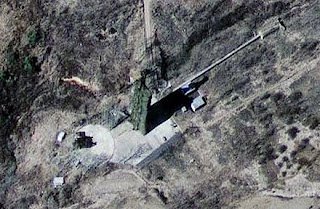North Korea is apparently in the final stages of preparing its Tapeodong-2 missile for launch.
Commercial imagery from DigitalGlobe, posted by GlobalSecurity.org, shows the the three-stage missile sitting on the launch pad at Musudan-ri. Analysts say the service arms on the tower are located away from the rocket. Fueling operations and final check-out could begin in a matter of days.
Imagery of the TD-2 at Musudan-ri, 29 March
Pyongyang has announced plans to launch the TD-2 in early April. North Korea claims the missile is a space launch vehicle that will put a communications satellite in orbit. But many intelligence analysts believe that the event is nothing more than a test of the long-range missile, capable of reaching targets in Alaska and Hawaii.
At this late juncture, the DPRK has even discontinued efforts to hide their preparations. GeoEye imagery from two days earlier (and published by the U.K. Telegraph), showed the missile covered by a shroud. While Pyongyang has used this technique before previous tests of the crude ICBM, the timing of the shroud’s removal–up to a week before the launch–reflects a highly confident North Korean regime.
March 27th imagery of the test site showed a shroud-covered TD-2 on the launch pad (GlobalEye via U.K. Telegraph)
And why not? On Sunday, Defense Secretary Robert Gates said there is “nothing” we can do to prevent North Korea from violating international law by launching the missile. Dr. Gates also told Chris Wallace of Fox News that it is “unlikely” that the U.S. or its allies will attempt to intercept the rocket, despite the availability of layered missile defenses across the Pacific region.
In the interview, Gates seemed to downplay the significance of the event, noting that senior U.S. officials do not believe that North Korea has the ability to mount a nuclear warhead on the missile.
With all due respect to the SecDef, his comments were little more than an exercise in verbal gymnastics. Truth be told, there is a lot we could do to stop the missile launch, from a cruise missile strike against the launch complex, to an in-flight intercept by U.S. and Japanese Aegis destroyers in the Sea of Japan, or land-based interceptor missiles in Alaska and Hawaii.
While the technology is capable–and maturing rapidly–the political will is non-existent. The Obama Administration has clearly decided that a successful intercept isn’t worth the geopolitical consequences. North Korea has threatened to pull out of the Six Party nuclear talks (and potential military strikes) if allied forces attempt to shoot down the TD-2.
But Mr. Gates and Mr. Obama should ask themselves a more salient question: are we prepared for the fallout for a successful missile test? In a matter of days, Pyongyang will fire a multi-stage missile across the airspace of a key American ally, and in the general direction of Alaska or Hawaii. If the TD-2 doesn’t fall apart, it will be a technical triumph for Kim Jong-il, a propaganda victory over the U.S., and a harbinger of things to come.
Rest assured, North Korea will eagerly share its long-range missile technology with other rogue states, including Iran. So, in a matter of a few years, we’ll have to worry about an ICBM threat from Tehran and Pyongyang–and the likely prospect that those missiles will carry a nuclear warhead.
But what about our efforts to deter the DPRK nuclear program? Well, if North Korea is willing to ignore various U.N. resolutions by launching its TD-2, then it will gladly violate the recent Six Party Accord. So much for years of “engagement,” and all that careful diplomacy, led by our new man in Baghdad, Ambassador Christopher Hill.
And, we haven’t even touched on the broader, regional implications of the pending test. Japan, South Korea and even Taiwan will be spurred to upgrade their military, and possibly join the nuclear club as well. U.S. relations will those countries–already strained by our coddling of North Korea–could easily fracture.
It’s a scenario that Mr. Obama and his advisers won’t discuss–at least publicly. From their perspective, the upcoming launch is an event to be “managed” for media implications, not the military consequences. They’ll worry about those pesky details somewhere down the road–the second term perhaps? We can only imagine what North Korea will have in its quiver by then.



